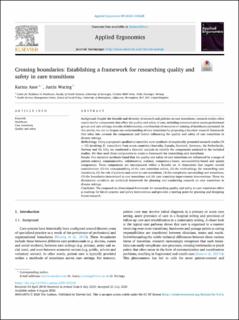| dc.description.abstract | Background
Despite the breadth and diversity of research and policies on care transitions, research studies often report similar components that affect the quality and safety of care, including communication across professional groups and care settings, transfer of information, coordination of resources or training of healthcare personnel. In this article, we aim to deepen our understanding of care transitions by proposing a heuristic research framework that takes into account the components and factors influencing the quality and safety of care transitions in diverse settings.
Methodology
Using a pragmatic qualitative narrative meta-synthesis of empirically grounded research studies (N = 13) involving 31 researchers from seven countries (Australia, Canada, Denmark, Germany, the Netherlands, Norway and the UK), we conducted a thematic analysis to identify the components analysed in the included studies. We then used these components to create a framework for researching care transitions.
Results
Our narrative synthesis found that the quality and safety of care transitions are influenced by a range of patient-centred, communicative, collaborative, cultural, competency-based, accountability-based and spatial components. These components are encompassed within a broader set of dimensions that require careful consideration: (1) the conceptualising of the care transition notion, (2) the methodology for researching care transitions, (3) the role of patients and carers in care transitions, (4) the complexity surrounding care transitions, (5) the boundaries intertwined in care transitions and (6) care transition improvement interventions. These six dimensions constitute an analytical framework for planning and conducting research on care transitions in diverse settings.
Conclusion
The proposed six-dimensional framework for researching quality and safety in care transitions offers a roadmap for future practice and policy interventions and provides a starting point for planning and designing future research. | en_US |

